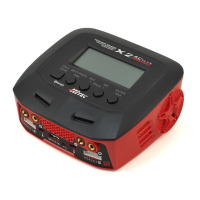7
When in doubt, always use a higher gauge wire (lower AWG number). It is
common to see charging leads constructed of 14AWG, 16AWG or 18AWG wire.
Always refer to recommendations from your battery manufacturer for your
specic battery type and size before initiating a charge or discharge process.
Do not attempt to disassemble or modify Lithium or Lead-Acid battery packs.
Discharging
The X2 AC Plus Black Edition discharging functions are for two specic purposes:
• Refreshing the capacity of a Nickel-based battery that has lost capacity over
time (NiMH or NiCd).
• Reducing the voltage of a Lithium battery for safe storage.
LITHIUM CHEMISTRY BATTERY PACKS SHOULD ONLY BE DISCHARGED
TO THEIR MINIMUM SAFE VOLTAGE, NO LOWER. DEEP DISCHARGING
A LITHIUM CELL WILL DO PERMANENT DAMAGE. REFER TO THE
STANDARD BATTERY PARAMETERS TABLE ON PAGE 6 OF THIS MANUAL
FOR MINIMUM DISCHARGE VOLTAGES.
LiPo & LiHV Charge/Discharge Cycling
Lithium batteries are known to reach full capacity after a break-in period of
about 10 charge/discharge cycles. We do not recommend you use the X2 AC
Plus Black Edition charger to do this; normal use and recharging will achieve
the same results. If you wish to perform a Lithium break-in on the bench with
the X2 AC Plus Black Edition, discharging to minimum acceptable voltages
and performing a balance charge at 1C maximum rate is recommended. If you
choose to break in your Lithium batteries under normal use, charging at only 1C
for the rst ten cycles will help ensure full performance and service life from your
Lithium cells.
Warning and Safety Notes [cont.]
Note

